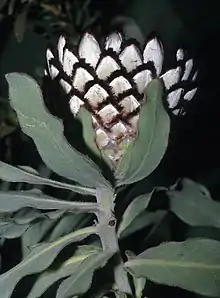Protea holosericea
Protea holosericea, commonly known as sawtooth sugar bush or sawedge sugarbush,[1][2] is a flowering shrub belonging to the Protea genus . The plant is endemic to South Africa and is found in the Sawedge peak on the Kwadousberg Mountains on the Western Cape.[1]
| Sawedge sugarbush | |
|---|---|
 | |
| Protea holosericea inflorescence at the Kirstenbosch National Botanical Garden | |
| Scientific classification | |
| Kingdom: | Plantae |
| Clade: | Tracheophytes |
| Clade: | Angiosperms |
| Clade: | Eudicots |
| Order: | Proteales |
| Family: | Proteaceae |
| Genus: | Protea |
| Species: | P. holosericea |
| Binomial name | |
| Protea holosericea | |
The shrub grows almost straight upright, grows up to 1.2 m high, and blooms from September to October.[3] Possible wildfires can destroy the mature plants, but the seeds will survive such an event. The seed is stored in a cap and spread by the wind. The plant is monoecious with both sexes in each flower. Pollination occurs through the action of birds. The plant grows on the dry, upper mountain slopes at altitudes of 1,200 to 1,300 metres.[3]
People who picked the plant's flowers caused the plant to almost die out in the 1970s.[3]
References
- "Sawedge Sugarbush". Red List of South African Plants. South African National Biodiversity Institute. 2012. Retrieved 10 July 2020.
- "Protea holosericea (Saw-edge sugarbush)". biodiversity explorer. Iziko Museums of South Africa. Retrieved 10 July 2020.
- "Bearded Sugarbushes - Proteas". Protea Atlas Project Website. 11 March 1998. Retrieved 10 July 2020.
| Taxon identifiers |
|---|